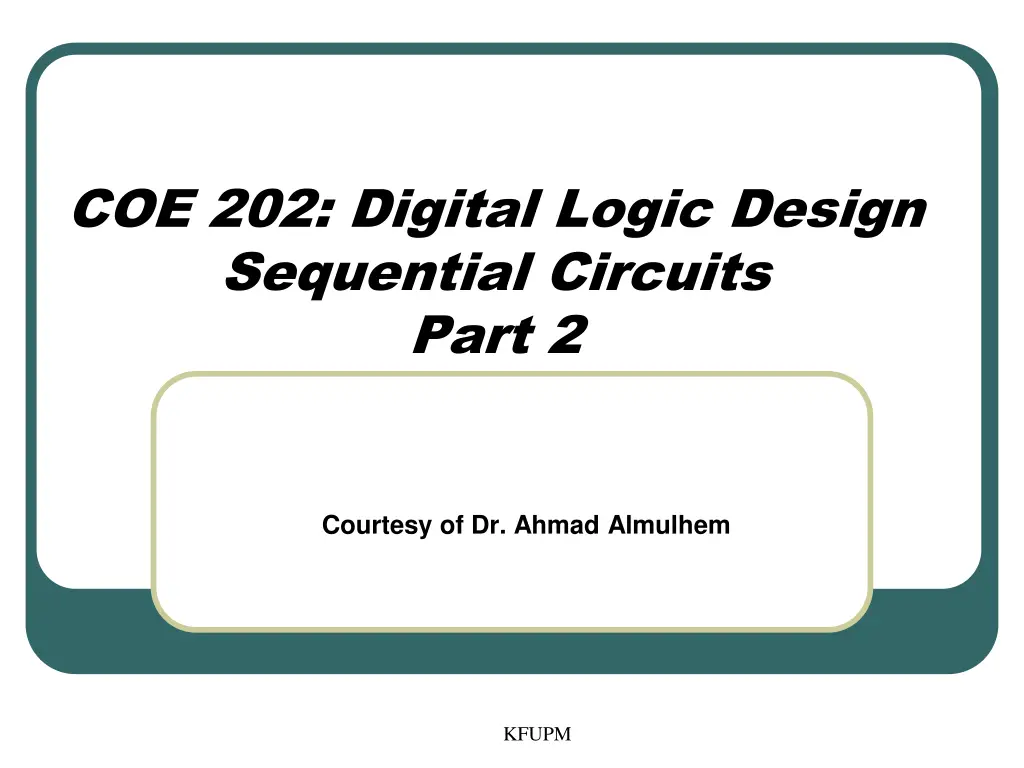
Digital Logic Design Sequential Circuits Analysis
"Explore the analysis of synchronous sequential circuits, including state equations, state tables, and state diagrams. Learn how to describe the behavior of clocked sequential circuits and differentiate between combinational and sequential circuits. Dive into examples and procedures for a comprehensive understanding. Courtesy of Dr. Ahmad Almulhem at KFUPM."
Download Presentation

Please find below an Image/Link to download the presentation.
The content on the website is provided AS IS for your information and personal use only. It may not be sold, licensed, or shared on other websites without obtaining consent from the author. If you encounter any issues during the download, it is possible that the publisher has removed the file from their server.
You are allowed to download the files provided on this website for personal or commercial use, subject to the condition that they are used lawfully. All files are the property of their respective owners.
The content on the website is provided AS IS for your information and personal use only. It may not be sold, licensed, or shared on other websites without obtaining consent from the author.
E N D
Presentation Transcript
COE 202: Digital Logic Design Sequential Circuits Part 2 Courtesy of Dr. Ahmad Almulhem KFUPM
Objectives Analysis of Synchronous Sequential Circuits Procedure Examples KFUPM
Analysis of Sequential Circuits Analysis is describing what a given circuit will do The behavior of a clocked (synchronous) sequential circuit is determined from the inputs, the output, and the states of FF Steps: Obtain state equations FF input equations Output equations Fill the state table Put all combinations of inputs and current states Fill the next state and output Draw the state diagram KFUPM
Analysis of Combinational vs Sequential Circuits Sequential : State Equations State Table State Diagram Combinational : Boolean Equations Truth Table Output as a function of input and current state Next state as a function of inputs and current state. Output as a function of inputs KFUPM
State Equations A state equation is a Boolean expression which specifies the next state and output as a function of the present state and inputs. Example: The shown circuit has two D-FFs (A,B), an input x and output y. The D input of a FF determines the next state A(t+1) = A(t)x+B(t)x = Ax+Bx B(t+1) = A (t)x = A x Output: y = (A+B)x KFUPM
State Table A state table is a table enumerating all present states, inputs, next states and outputs. Present state, inputs: list all combinations Next states, outputs: derived from state equations 4 sections KFUPM
State Table A state table is a table enumerating all present states, inputs, next states and outputs. Present state, inputs: list all combinations Next states, outputs: derived from state equations 2-D Form KFUPM
State Diagram The state diagram is a graphical representation of a state table (provides same information) Circles are states (FFs), Arrows are transitions between states Labels of arrows represent inputs and outputs KFUPM
Analysis of Sequential Circuits Analysis is describing what a given circuit will do The behavior of a clocked (synchronous) sequential circuit is determined from the inputs, the output, and the states of FF Steps: Obtain state equations FF input equations Output equations Fill the state table Put all combinations of inputs and current states Fill the next state and output Draw the state diagram KFUPM
Example 1 Analyze this circuit? Is this a sequential circuit? Why? How many inputs? How many outputs? How many states? What type of memory? KFUPM
Example 1 (cont.) D Flip Flop (review) Characteristic Tables and Equations Q(t) 0 0 1 1 D 0 1 0 1 Q(t+1) 0 1 0 1 D 0 1 Q(t+1) 0 1 Q(t+1) = D KFUPM
Example 1 (cont.) KFUPM
Example 1 (cont.) State equations: DA = AX + BX DB= A X Y = (A + B) X KFUPM
Example 1 (cont.) State equations: DA = AX + BX DB= A X Y = (A + B) X State table: KFUPM
Example 1 (cont.) State equations: DA = AX + BX DB= A X Y = (A + B) X State table (2D): KFUPM
Example 1 (cont.) State equations: DA = AX + BX DB= A X Y = (A + B) X State table: State diagram: KFUPM
Example 2 Analyze this circuit. What about the output? This circuit is an example of a Moore machine (output depends only on current state) Mealy machines is the other type (output depends on inputs and current states) KFUPM
Example 2 (cont.) Equation: DA = A X Y KFUPM
Example 2 (cont.) Equation: DA = A X Y 0/0 1/1 KFUPM
Mealy vs Moore Finite State Machine (FSM) Mealy FSM: Output depends on current state and input Output is not synchronized with the clock Moore FSM: Output depends on current state only KFUPM
Summary To analyze a sequential circuit: Obtain state equations FF input equations Output equations Fill the state table Put all combinations of inputs and current states Fill the next state and output For the next state use characteristic table/equation Draw the state diagram Two types of synchronous sequential circuits (Mealy and Moore) KFUPM
